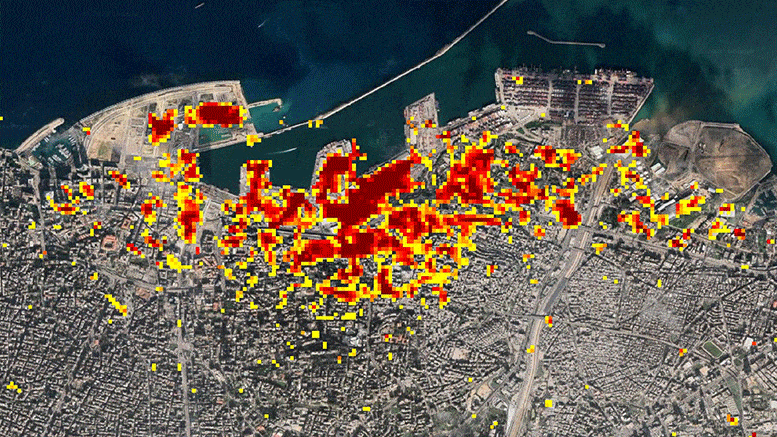

NASA’s ARIA team, in collaboration with Singapore’s Earth Observatory, used satellite data to map the extent of likely damage following a massive explosion in Beirut. Dark red pixels represent the most damage. Areas in orange are moderately damaged, and areas in yellow are likely to have suffered some less damage. Each colored pixel represents an area of 30 meters (33 yards). The map contains customized data from Copernicus Sentinel processed by ESA (European Space Agency) and analyzed by ARIA team scientists at NASA’s Jet Propulsion Laboratory, Caltech, and Earth Observatory of Singapore. Based in Pasadena, California, Caltech manages JPL for NASA.
Scientists are using satellite data to track map changes in the aftermath of the recent explosion.
NASAThe team of Advanced Rapid Imaging and Analysis (ARIA), in collaboration with the Earth Observatory of Singapore, used satellite-derived synthetic aperture radar data to map the probable extent of damage caused by a massive August 4 explosion in Beirut. Synthetic aperture radar data from space shows changes in ground surface from before and after a major event such as an earthquake. In this case, it is used to show the devastating result of an explosion.
On the map, dark red pixels – such as those present at and around the port of Beirut – represent the most damage. Areas in orange are moderately damaged and areas in yellow are likely to have suffered some less damage. Each colored pixel represents an area of 30 meters (33 yards).
Maps like these can help identify severely damaged areas where people need help. The blast occurred near the city’s port. It claimed more than 150 lives and caused billions of dollars in damage.
The map contains adapted data from Copernicus Sentinel processed by ESA (European Space Agency) and analyzed by scientists from ARIA team at NASA JPL, Caltech, and Singapore Earth Observatory. Located in Pasadena, California, Caltech manages JPL for NASA.